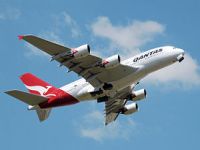Unmanned aircraft: No thanks
The latest gossip has it that pilotless aircraft are soon to take to the skies, ferrying passengers from one part of the globe to another in an entirely automated process. Until what point does robotics have a use and at which point does the human being become redundant?

"Bugsplat!" shout the controllers of NATO unmanned aircraft, or Unmanned Aerial Vehicle, UAV, when from thousands of miles away they target someone on the ground somewhere hot and far-off. BANG! goes the drone. "BUGSPLAAAATT!" shouts the demented murderer from his computer console as he pumps the air with his arm and gets pats on the back from his fellows in crime in the control room.
This is (not) a nice example of where the human being controls the robot. But what about when human beings sit inside the robot, hundreds of them, and instead of hearing the familiar message from the flight deck about 30,000 feet and the outside temperature being minus whatever and the local time and temperature, they know that nobody is sitting on the flight deck?
Under normal circumstances, there would be a captain sitting on the left and a first officer sitting on the right, either them being the Pilot In Command (PIC), usually one on the outward leg and the other on the second leg.
In an emergency, the captain (usually the one with more experience in that type of aircraft) might assume control while the First Officer assumes control of communications and indeed in some airports, only captains have permission to perform a landing. The cockpit resource management (CRM), namely the communication between the two pilots as they pool experience to stabilise the aircraft in abnormal situations, is the main asset on board which will guarantee that a tricky situation does not become a critical one as they go through their checklist of operations to perform.
While the major part of the flight is automated these days, the pilots are there to check that systems are functioning and to check if there are anomalies. Just occasionally, these appear. For example, what happened to the pitot tubes on the Air France Flight 447 from Rio de Janeiro to Paris in May 2009? Why didn't the automated Airbus system kick in to stabilise the aircraft, and why did it stall?
And what happens when there is a near collision near the ground and the TCAS (Traffic Collision Avoidance System) sends one aircraft down and the other one up, but the lower aircraft is too low and activates the alarm "Terrain, terrain. Pull up, pull up"?
What happens when there are conflicting head winds, tail winds and crosswinds with gusts greater than that which the aircraft is designed to withstand and windshear as the aircraft makes its final approach? Is the automated system going to simply activate the standard routine or do something "iffy" which in the event is the only way to put the equipment on the floor?
While Airbus is the plane for engineers and Boeing the aircraft for pilots, in both cases, give me a pilot, please.
Timothy Bancroft-Hinchey
Pravda.Ru
Subscribe to Pravda.Ru Telegram channel, Facebook, RSS!


